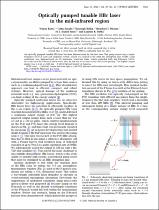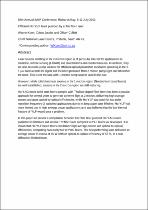JavaScript is disabled for your browser. Some features of this site may not work without it.
- ResearchSpace
- →
- Research Publications/Outputs
- →
- Conference Publications
- →
- View Item
Influence of laser parameters on laser ultrasonic efficiency
Laser ultrasonics is currently the optimal method for non-destructive testing of composite materials in the aerospace industry. The process is based on a laser-generated ultrasound wave which propagates inside the composite. The response at the material surface is detected and converted into a defect map across the aircraft. The design and optimisation of a laser system for this application is reviewed in this paper, together with the basic science involved. This includes the optimisation of laser parameters, such as output couplers and gas mixture, and the impact these choices have on the laser chemistry. The authors present a theory for the catalytic recombination of the gas which shows excellent agreement with experiment. Finally, an operating laser system for this application, yielding a six-fold improvement in performance over conventional laser systems, is described.
Reference:
Forbes, A, et al. 2007. Influence of laser parameters on laser ultrasonic efficiency. Proceedings of SPIE, vol. 6346
Forbes, A., Botha, L., Du Preez, N., & Drake, T. (2007). Influence of laser parameters on laser ultrasonic efficiency. The International Society for Optical Engineering. http://hdl.handle.net/10204/1009
Forbes, A, L Botha, N Du Preez, and T Drake. "Influence of laser parameters on laser ultrasonic efficiency." (2007): http://hdl.handle.net/10204/1009
Forbes A, Botha L, Du Preez N, Drake T, Influence of laser parameters on laser ultrasonic efficiency; The International Society for Optical Engineering; 2007. http://hdl.handle.net/10204/1009 .
http://spiedl.aip.org/
2007
Files in this item
Related Items
This item appears in the following Collection(s)
Related items
Showing items related by title, author, creator and subject.
-
-
Author: Koen, W ; Jacobs, Cobus ; Bollig, C ; Strauss, Hencharl J ; Esser, MJD ; Botha, LR Date: Jun 2014 An optically pumped tunable HBr laser has been demonstrated for the first time. The pump source was a single-frequency Ho:YLF laser and amplifier system, which was locked to the 2064 nm absorption line of HBr. Laser oscillation was demonstrated ... Read more
-
Author: Koen, W ; Jacobs, Cobus ; Collett, O Date: Jul 2013 Laser sources emitting in the 2 micron region is of particular interest for applications in medicine, remote sensing (LIDAR) and directed infra-red countermeasures. In addition, they are also desirable pump sources for efficient optical ... Read more
Browse
-
All of ResearchSpace
-
This Collection
Legislation and compliance
General Enquiries
Tel: + 27 12 841 2911
Email: callcentre@csir.co.za
Physical Address
Meiring Naudé Road
Brummeria
Pretoria
South Africa
Postal Address
PO Box 395
Pretoria 0001
South Africa
Copyright © CSIR 2017. All Rights Reserved
Resources on this site are free to download and reuse according to associated licensing provision. Please read the terms and conditions of usage of each resource.








